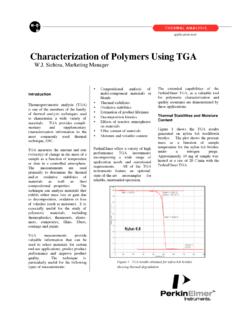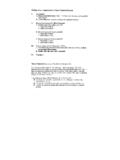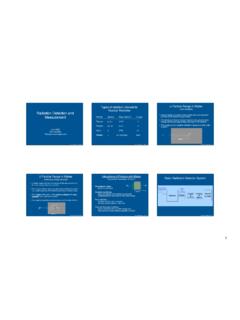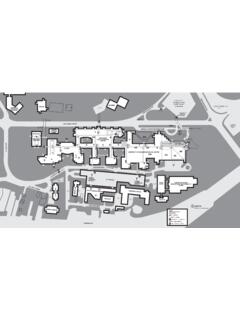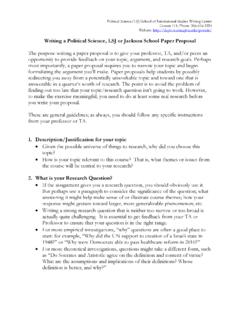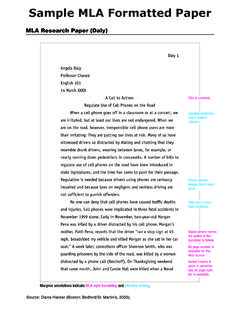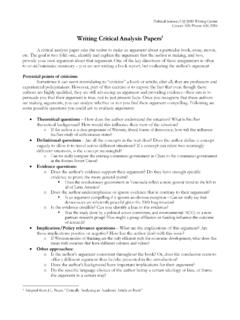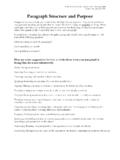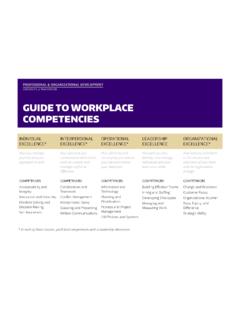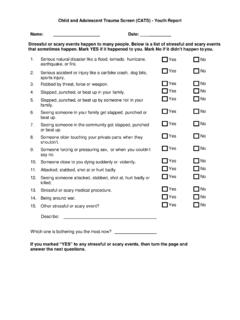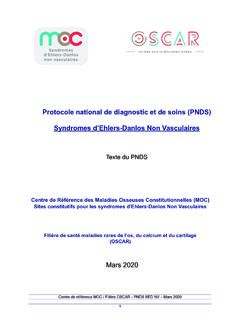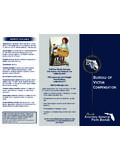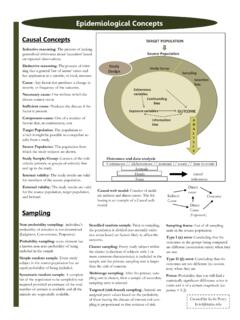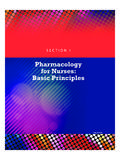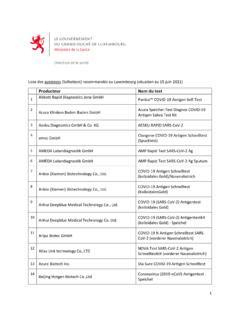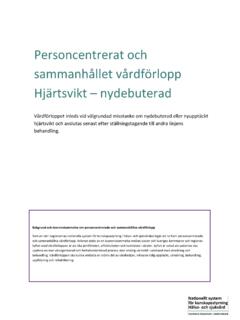Transcription of CHILDREN’S SLEEP HABITS QUESTIONNAIRE (CSHQ) The …
1 CHILDREN'S SLEEP HABITS QUESTIONNAIRE (CSHQ). The Children's SLEEP HABITS QUESTIONNAIRE (CSHQ): Psychometric Properties of A Survey Instrument for School-Aged Children Judith A. Owens MD, MPH,1 Anthony Spirito PhD,2 and Melissa McGuinn BS3. 1 Division of Pediatric Ambulatory Medicine, Rhode Island Hospital, Associate Professor of Pediatrics, Brown University School of Medicine 2 Child and Family Psychiatry, Rhode Island Hospital, Professor of Psychiatry and Human Behavior, Brown University School of Medicine 3 Child and Family Psychiatry, Rhode Island Hospital, Brown University School of Medicine Study Objectives: To present psychometric data on a comprehensive, parent-report SLEEP screening instrument designed for school-aged children, the Children's SLEEP HABITS QUESTIONNAIRE (CSHQ). The CSHQ yields both a total score and eight subscale scores, reflecting key SLEEP domains that encompass the major medical and behavioral SLEEP disorders in this age group.
2 Design: Cross-sectional survey. Setting: Three elementary schools in New England, a pediatric SLEEP disorders clinic in a children's teaching hospital. Participants: Parents of 469 school-aged children, aged 4 through 10 years (community sample), and parents of 154 patients diag- nosed with SLEEP disorders in a pediatric SLEEP clinic completed the CSHQ. Interventions: N/A. Measurements and Results: The CSHQ showed adequate internal consistency for both the community sample ( = ) and the clinical sample ( = ); alpha coefficients for the various subscales of the CSHQ ranged from (Parasomnias) to (Bedtime Resistance) for the community sample, and from (Parasomnias) to ( SLEEP -Disordered Breathing) for the SLEEP clinic group. Test-retest reliability was acceptable (range to ). CSHQ individual items, as well as the subscale and total scores were able to consistently differentiate the community group from the SLEEP -disordered group, demonstrating validity.
3 A cut-off total CSHQ score of 41 generated by analysis of the Receiver Operator Characteristic Curve (ROC) correctly yielded a sensitivity of and speci- ficity of Conclusions: The CSHQ appears to be a useful SLEEP screening instrument to identify both behaviorally based and medically- based SLEEP problems in school-aged children. Key words: SLEEP HABITS ; SLEEP survey; SLEEP disorders; pediatrics INTRODUCTION to considerable difficulties in comparing results across studies. Few of the SLEEP survey methods used in school- IN CONTRAST TO WHAT IS KNOWN ABOUT SLEEP . aged children examine both behaviorally-based (Limit HABITS AND SLEEP DISTURBANCES IN INFANTS. Setting SLEEP Disorder, SLEEP Onset Association Disorder, AND TODDLERS1-4 AND IN PRESCHOOL-AGED. etc.) and medical (Obstructive SLEEP Apnea, Narcolepsy, CHILDREN,5-7 relatively few studies have addressed these etc.) SLEEP disorders, and most have not been formulated issues in latency-aged Those studies which according to any of the standardized systems for catego- have examined SLEEP behavior in middle childhood11-13.
4 Rization of clinical SLEEP disorders such as is contained in have employed a variety of different interviews, brief ques- the International Classification of SLEEP Disorders (ICSD). tionnaires, and SLEEP survey instruments, many of which do Finally, the definition of a SLEEP disturbance . not have reliability and validity data reported. This has led vs. a SLEEP behavior in these studies has been based on often arbitrary thresholds set by the authors and have not Accepted for publication September 2000 included parental definitions of SLEEP problems in the con- Address correspondence to: Judith A. Owens, MD, MPH, Pediatric Ambulatory text of the individual family. Medicine, Rhode Island Hospital, 593 Eddy St., Potter Bldg., Suite 200, We present preliminary reliability and validity data on Providence, RI 02903. Tel: 401-444-8280; Fax: 401-444-6218;. a parent-report SLEEP screening survey specifically E-mail: SLEEP , Vol.
5 23, No. 8, 2000 1 Children's SLEEP HABITS QUESTIONNAIRE (CSHQ) Owens et al designed for school-aged (4 years through 10 years) chil- confirmed by standard one-night in-hospital polysomno- dren, the Children's SLEEP HABITS QUESTIONNAIRE (CSHQ). graphic (PSG) evaluation, including EEG monitoring for The design of the CSHQ is based on common clinical SLEEP staging, using a cut-off respiratory disturbance index symptom presentations of the most prevalent pediatric of >1 to define The mean age of the clinical sample International Classification of SLEEP Disorders diag- was years (SD= yr.). There were 91 boys ( ). and 63 girls ( ). The mean Hollingshead SES score was (SD= ). METHODS The characteristics of the three clinical sample diagnos- tic groups were as follows: Behavioral SLEEP Disorders Participants group (n=43) (including Limit Setting SLEEP Disorders, The community sample population consisted of 1099 SLEEP Onset Association Disorder, and Adjustment SLEEP students aged 4 10 years inclusive, enrolled in three pub- Disorder); 22 M, 21 F; mean age = years (SD= ).
6 Lic elementary schools, each of which was comprised of Parasomnias group (n=45) (including Sleepwalking, Night grades kindergarten through fourth grade. The three Terrors and Confusional Arousals); 25 M, 20 F; mean age schools were in a predominantly white, middle-income, = years (SD= ); and SLEEP -Disordered Breathing English-speaking suburban school district in Southeastern group (n=66); 44 M, 22 F; mean age = years (SD= ). New England and were selected both on the basis of acces- sibility and as representative of a typical suburban commu- MEASURE. nity school system. Participants from each of the three The Children's SLEEP HABITS QUESTIONNAIRE (CSHQ). schools were surveyed separately during one of three peri- The CSHQ is a retrospective, 45-item parent QUESTIONNAIRE ods during the school year (Spring, Fall, Winter), in order that has been used in a number of studies to examine SLEEP to minimize potential seasonal differences in SLEEP HABITS .
7 Behavior in young The CSHQ includes items Sixty parents also responded voluntarily to a request for relating to a number of key SLEEP domains that encompass test-retest completion of the survey approximately two the major presenting clinical SLEEP complaints in this age weeks later. group: bedtime behavior and SLEEP onset; SLEEP duration;. Of the total of 1099 QUESTIONNAIRE packets mailed, 520. anxiety around SLEEP ; behavior occurring during SLEEP and questionnaires were not returned; there were 54 refusals, night wakings; SLEEP -disordered breathing; parasomnias;. and 10 subjects moved (response rate = ). Twenty-six and morning waking/daytime sleepiness. Parents are asked 11-year-old children were eliminated because of the deci- to recall SLEEP behaviors occurring over a typical recent sion to restrict the sample age distribution in order to min- week. Items are rated on a three-point scale: usually if imize possible pubertal influences on SLEEP .
8 Twenty chil- the SLEEP behavior occurred five to seven times/week;. dren were excluded from the final sample because of a par- sometimes for two to four times/week; and rarely for ent-reported history of having been diagnosed with a psy- zero to one time/week. Some items were reversed in order chiatric condition (such as ADHD or depression) that could to consistently make a higher score indicative of more dis- impact on SLEEP onset or night wakings and/or were receiv- turbed SLEEP . ing medication with likely effects on SLEEP , such as psy- chostimulants, anticonvulsants, or antihistamines. The final Reduction of SLEEP Variables. For the purposes of fur- sample consisted of 469 children. The mean age of the sam- ther psychometric evaluation analysis, some of the CSHQ. ple was years years. There were 240 boys ( ) items were eliminated as redundant or ambiguous, and the and 229 girls ( ).
9 15 Socioeconomic status was deter- remaining 35 were conceptually grouped into eight sub- mined using the Hollingshead Form Index of Social scales reflecting the following SLEEP domains: 1) Bedtime Status15 which is based on occupation and education. The Resistance, 2) SLEEP Onset Delay, 3) SLEEP Duration, 4). mean Hollingshead SES score was (SD= ). SLEEP Anxiety, 5) Night Wakings, 6) Parasomnias, 7) SLEEP - The clinical population consisted of 154 patients con- Disordered Breathing, 8) Daytime Sleepiness. Total SLEEP secutively diagnosed with a behavioral SLEEP disorder, a Disturbance score included all items of the eight subscales, parasomnia or SLEEP -disordered breathing in a pediatric but consisted of only 33 items because two of the items on SLEEP disorders clinic in a children's teaching hospital in the Bedtime Resistance and SLEEP Anxiety subscales were Southeastern New England.
10 The data was collected over a identical. Items contained in each of the subscales are list- four year period due to presentation rates of the specific ed in Table 1. diagnostic entities in the selected age group. Patients were Statistical Analysis. The subscales were assessed for divided into the three primary diagnostic groups following internal consistency using Cronbach's -coefficients. an extensive evaluation in the SLEEP clinic. In addition, the Means and standard deviations of each item in the sub- diagnosis of Obstructive SLEEP Apnea Syndrome (OSAS) scales and the total subscale scores are listed in Table 1. in all patients in the SLEEP disordered breathing group was Test-retest reliability was calculated using Pearson's corre- SLEEP , Vol. 23, No. 8, 2000 2 Children's SLEEP HABITS QUESTIONNAIRE (CSHQ) Owens et al SLEEP , Vol. 23, No. 8, 2000. Table 1 Unadjusted Means, Standard deviations for individual items and subscales, N, F values, Test-retest, and Alpha coefficients for the Subscales of the CSHQ.
